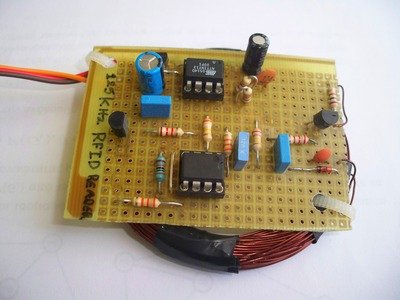Introduction
This RFID reader works with 125 kHz tags in credit card size shape cards and with 125 kHz key fobs (picture 1). The EM4100 protocol is used. When you approach an RFID Tag close enough (4-5 cm) to the reader’s coil (L1) the reader will read the 10-digit unique ID of the Tag and transmit it as ASCII characters trough the serial output with 2400 bits per second.
The circuit includes a buzzer that beeps when a Tag is read successfully.
Description
I will try to explain with simple words how the RFID works. The ATtiny13 uses the PWM function to produce an 125 kHz square wave signal. This signal comes out from PB0 pin. On the falling edge of the PB0 (Logic ‘0’), the T1 does not conduct.So the L1 is energized from R1 (100 ohm) with +5V. When PB0 pin is rising (Logic ‘1’) the T1 is conducting and one side of L1 goes to GND. The L1 goes in parallel with C2 creating an LC oscillator. These transitions of L1 to logic ‘1’ and logic ‘0’ are made 125000 times in one second (125 kHz).
Picture 3: The 125 kHz waveform that is transmitted from L1 and C2 components.
The RFID reader provides energy to the transponder (Tag) by creating an electromagnetic field. The energy transmission between the RFID reader and the Tag is the same as transformers convert the voltage from the 220V AC power network to 12V AC, based on the magnetic field that creates the primary coil. In our case the primary coil is the RFID reader and the secondary coil is the RFID tag. The only difference is that on RFID circuits there is no iron core between the two coils (one coil is on the reader side and the other coil is in to the RFID tag). The D1 ,C3 and R5 components constitute an AM signal demodulator (AM = Amplitude Modulation) .
For more detail: 125 kHz RFID reader based on ATtiny13

